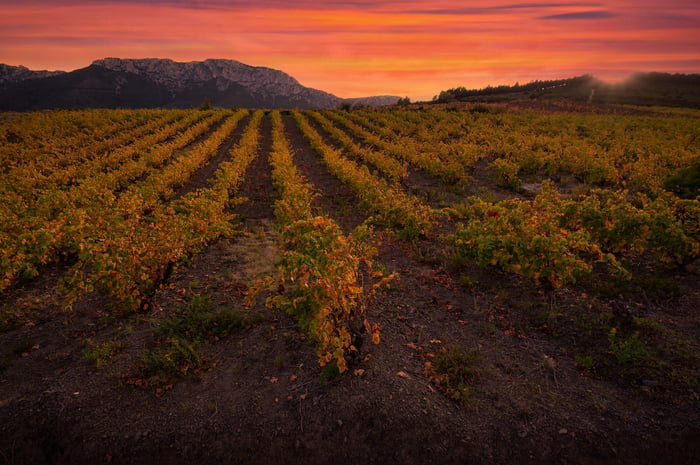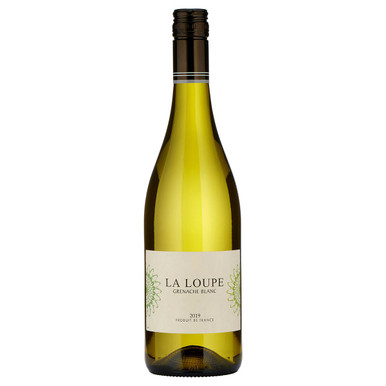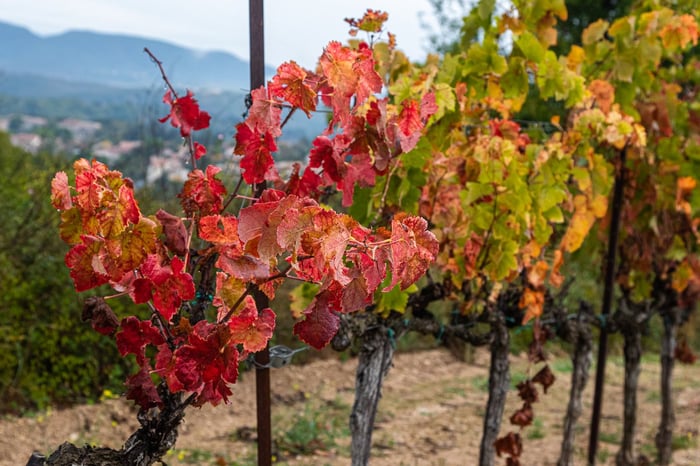
Grape varieties of the Languedoc-Roussillon
While some regions like Burgundy specialise in a tiny number of grape varieties, the vineyards of Languedoc-Roussillon have a whole cocktail of different ones reflecting the diversity of wines made in this vast region. There are so many that it’s hard to keep track of them all. I’ve even heard rumours that there’s a little Zinfandel planted near Beziers!
To make thing simpler, I’ve made the unilateral decision to exclude so-called international varieties like Chardonnay and Cabernet Sauvignon despite both making fine wines in the region. Though I have included foreign interlopers like Grenache because despite its Spanish origins, it’s so firmly entrenched that it would be eccentric to leave it out.
Right, without further ado, let’s dive into the grape varieties of the Languedoc-Roussillon!
Red grapes
Alicante Bouschet
A crossing between Grenache and Petit Bouschet also known as Garnacha Tintorera, this is notable for having red flesh so produces wines with a lot of colour. It has thick skin and the tannins can be harsh. Once one of the most planted grapes in the Languedoc, it’s rarely seen these days though it’s still popular in Portugal and California.
Carignan
A somewhat maligned variety and in some cases with good reason. If you try to take too many grapes from a Carignan vine, the resulting wines can acidic and lacking in fruit with rustic tannins, but get it properly ripe and there’s no variety that reflects the terroir of the Languedoc better. It responds well to carbonic maceration to bring out dark fruit and herb flavours turning an ugly duckling into a swan. At one point there were grants to pull up this variety up. These days in contrast, old vine Carignan is treasured for producing bold wines like Alo Jais Noir.
Alo Jais Noir Carignan 2022, Roussillon

£13.65
Big, bold and concentrated Carignan Noir that leaves a big, bold impression. Winemaker Guillaume Letang went on a voyage to vineyards unknown to source these...… read more
Cinsault
Cinsault too has long been dismissed, thought only suitable for rosé. It’s a pale-skinned variety that produces light wines especially if yields are too high. Much was grubbed up in the 1980s and replaced with Syrah or Mourvedre. But in recent years, growers are beginning to appreciate its subtle charms. One of its strengths that it shares with Carignan is an ability to keep freshness and moderate alcohol in a warming climate so it's a great blending partner but can be sublime on its own. Definitely a variety that hasn't reached its full potential yet.
Grenache
Originally from Aragon in Spain, Grenache has been at home in the south of France for such a long time that it feels like a French variety. It’s usually blended in the Languedoc-Roussillon to produce AOC wines such as Faugeres and Pic St. Loup though there are some great varietal versions like La Loupe Grenache Noir . It does have a propensity to being overly alcoholic, jammy and prone to oxidation but with the right sites and handling Grenache can produce wines of such beauty and fragrance that you will understand why it’s known as the Pinot Noir of the South.
Marselan
This is a cross created in 1961 between Grenache and Cabernet Sauvignon. It has some of the raspberry fruit of the former and structure of the latter. While often used in blends, it also produces some good varietal wines like Domaine de l'Armet Marselan.
Domaine de l'Armet Marselan 2023, Languedoc

£16.50
This organic French red wine is made from 100% Marselan, a grape created by crossing Grenache and Cabernet Sauvignon, which provides an insight to what...… read more
Morrastel
Known as Graciano in Spain where it adds spice, colour and freshness to Rioja blends, Morrastel has a small presence in the Languedoc. It’s a permitted variety in the Grés de Montpellier AOC and makes up about 10% of the blend of Abbaye de Valmagne Cardinal de Bonzi where it provides a distinctive bright note to the finish.
Mourvedre
Another Spaniard, probably, where it’s known as Monastrell, Mourvedre finds its apotheosis in Bandol over in Provence. It can be a tricky one to ripen in the Languedoc-Roussillon veinyards as it needs both heat and ideally proximity to the ocean as it loves humidity. Along with Syrah its use was encouraged as a so-called cepage ameliorateurs by authorities in the 1980s. It’s usually seen in blends with Grenache, Syrah and others. When properly ripe you’ll find deeply-coloured wines with flavours of black olives and wild herbs like Abbaye de Valmagne "Turenne".
Abbaye de Valmagne "Turenne" Rouge 2020, Languedoc

£23.50
The Abbey of Valmagne, also called the Cathedral of the Vineyards, sits just outside Montpellier. In 1838 the abbey was aquired by the Count of...… read more
Syrah
Syrah is such a fixture in the Languedoc-Roussillon, it’s hard to imagine that it is also a newcomer. Until the 1980s Syrah was rarely seen outside the Rhone valley but was encouraged as a cepage ameliorateurs to beef up (unfairly) maligned varieties like cinsault and carignan. Syrah is usually blended with grenache, mourvedre and other varieties in AOC wines like Corbieres and St. Chinian but he's also a strong solo performer. Cooler climate syrah tends towards raspberry and black pepper with a distinct floral note like violets or lavender while in hotter terroirs you’ll find dark cherry, chocolate and liquorice.
White grapes
Clairette
Like Piquepoul, Clairette was originally planted for the vermouth industry but as growers in Châteauneuf-du-Pape know, it can make superb dry table wines. Single varietal Clairette can be quite neutral and lemony at first but with a moreish texture that makes it hard to resist another glass.
Grenache Blanc
This is Grenache’s white cousin, there’s also Grenache Gris, and provides the base for many Languedoc wines. Its flavours are hard to put a finger on but tend towards the herbal and textured. You can feel Grenache Blanc more than taste it. It works brilliantly with grapes like Viognier providing the fruit but also seen on its own as with La Loupe Grenache Blanc.
La Loupe Grenache Blanc 2024, Languedoc

£12.00
This French white wine is a hidden gem from this rarely encountered single varietal. La Loupe has a lovely dry and richly textured palate, it...… read more
Macabeo
You might know Macabeo as Viura which it’s called in Rioja. It’s also one of the big three Cava varieties. As in Spain, Macabeo can be underwhelming if not fully ripe but should show an unusual floral and slightly earthy flavour. Usually seen blended.
Mauzac
Rarely seen elsewhere, Mauzac is big in the cool climates of Limoux where it’s used to make sparkling wine, often blended with Chenin Blanc and Chardonnay. It’s notable for its distinct appley taste.
Marsanne
Marsanne is another import from the Northern Rhone which is now fully at home in the Languedoc. The variety shows flavours of stone fruit, honey and orange blossom and like its close relation Roussanne often has a distinct creamy, almond-like texture. It’s usually seen in blends with Grenache Blanc and other varieties such as Petit Paradis St. Chinian.
Petit Paradis 2022, Saint Chinian

£13.50
White wines account for just 1% of the production of the Saint Chinian appellation, which makes this Petit Paradis as precious as it is rare....… read more
Piquepoul
Picpoul de Pinet (just to keep us on our toes, the variety on its own is spelt ‘Piquepoul’) has been one of the great Languedoc success stories of the past 30 years. Originally planted to go into Noilly Prat vermouth, growers in the 1990s discovered that temperature-controlled fermentation brought out flavours of grapefruit and sea air to produce the ultimate oyster wine like this Picpoul Soleil. There's also a rare Piquepoul Noir which is usually used to make pinks like Piquepoul Rosé Foncalieu.
Roussanne
Roussanne along with Marsanne is the great white grape of Hermitage in the Northern Rhone. In the Languedoc-Roussillon it's usually blended to Marsanne, Viognier and others in AOC wines like Faugeres where it provides weight, texture and often a distinct marzipan note.
Rolle
You’ll probably know Rolle better as Vermentino but in their wisdom the authorities decreed recently that it could only be known by its French name which is much harder to pronounce. It’s a lowish acidity grape, originally from Italy, which fully ripe taste of oranges and apricot kernels. Try this example from Chateau Coujan.
Château Coujan Roc & Rolle (Organic) 2022, Languedoc

£13.95
The name is a clever pun on the Roc-ky soils where the grapes grow and the new name for Vermentino (which the French must now...… read more
Viognier
Originally a rare grape from the Rhone valley, Viognier is now widely planted in the Languedoc-Roussillon. It can be a tricky one to get right: too ripe and it loses acidity and feels flabby, underripe it just tastes grassy. But varietal examples can be excellent and it is useful in blends with Grenache Blanc and others where even a small proportion adds a big dollop of apricot.




